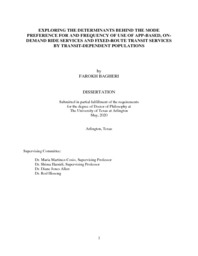| dc.description.abstract | In recent decades, the development of diverse types of transportation systems to meet the needs of people in all parts of a country is a trend in urban development that is in line with interest in the sustainable development of communities. This development has prompted transportation policymakers to adopt policies to improve the transportation conditions of the community, while citizens, in the face of these policies, make decisions in choosing the type of transportation system that is possible, and may be different from the policy makers' management programs. Therefore, paying attention to people's views and their awareness of their preferences can help policymakers in predicting travel behavior and thus aid policymakers in adopting proper management policies. In this regard, the present study, titled " Exploring the Determinants Behind the Mode Preference For and Frequency of Use of App-Based, On-Demand Ride Services and Fixed-Route Transit Services by Transit-Dependent Populations" examined the preferences of transit-dependent citizens from 48 cities in 27 U.S. states in 2019-2020. This study examines the travel behavior of transit-dependent individuals and their preferences for the use of traditional public transit services as compared to the app-based, on-demand ride services (also known as ridehailing), as the new generation of transportation systems. Using random sampling and Cochran's formula, 385 people were selected as the sample and a questionnaire was given to these people using Qualtrics. Thirty-one participants were excluded from the final analysis for various reasons, such as the presence of paradoxical answers in the questionnaire, misspellings, and taking less than the standard response time to complete the questionnaire. Finally, 354 people were analyzed as the sample for this study. The data collected by the questionnaire were analyzed by SPSS and AMOS software, and the final analysis used the SEM model, testing two approaches including one in which the built environment variables were entered, and a second without entering these variables. The findings indicate the appropriate goodness of fit of the model. Theoretically, I have used two theories of the Planned Behavior by Icek Ajzen (Ajzen, 1991) to discuss the sample’s modal prefrences. This study may serve as one of the first comprehensive survey investigations which examines the determinants behind the modal preferences and the usage frequency of use of both ridehailing services and fixed-route transit by transit-dependent people in the form of a single model simultaneously.
The results showed that the overall preference for using private ride services has a positive effect on the percentage of ridehailing trips made by transit-dependent people, and the overall preference for using fixed-route transit services has an inverse effect on the percentage of ridehailing trips. Also, the effects of employment density, population density, preference for living in compact neighborhoods, and land use mix on the percentage of ridehailing trips were not confirmed. Moreover, the study of the direct effects of the independent variables in the model showed that the overall preference for using fixed-route transit is the strongest predictor of the percentage of ridehailing trips made by transit-dependent people, among the studied variables.
In contrast with the research literature, the study found that the built environment variables had no effects on the people's travel behavior. To explain this discrepancy between the research findings and the research literature, the status of the three built environment variables including population density, employment density, and land use mix in the residence of the sample, was examined. Through this examination, it was found that the residences of the sample population are at a very low level in terms of population density, employment density, and land use mix. Thus, it can be argued that it is possible that this ineffectiveness of the built environmental variables is due to the low density of the population and employment, as well as the low diversity of the land uses in the residence of the sample. | |


